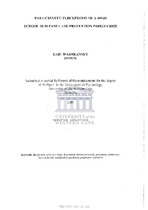| dc.description.abstract | There are many theories as to why adolescents engage in substance abuse. These
theories have formed the basis of various substance abuse prevention programmes
aimed at reducing this problem. Evaluation of these interventions is needed in order to assess their effectiveness and to improve on future prevention strategies. The literature highlights tensions and differences between the primary preventative
approaches to substance abuse and the harm reduction model. It also suggests that
psychosocial or life skills programmes and interventions employing a harm reduction approach tend to be viewed as more suitable for adolescents than other approaches. This study focuses on a high school intervention programme running since 1996, which has not yet been evaluated. It aimed to identify the programme's strengths and weaknesses, as well as participants' perception of the intervention. A qualitative research method was used, employing focus groups as the tool for data gathering. The sample for the study was made up of 30 volunteers from three grade 10 classes that completed the programme two years prior to this study. Data was transcribed verbatim and analyzed using thematic analysis. Links were made to the two approaches referred to above. Analysis of the data indicated that although stories used to warn and frighten people were shown to have a shocking impact on the participants, pupils found it difficult to make the connection between the speakers' horrific stories and their own experimentation with drugs and alcohol. It was found that participants appreciated the fact that they were being informed about the dangers of substance use, and that they were encouraged to take responsibility for their own decisions regarding this behaviour. The informal, non-judgemental stance of the speakers served to reinforce this message. In conclusion, the study indicated that the different methods used in the various prevention programmes are in fact not altogether different. It is suggested that the various models are potentially compatible, and can perhaps work together to establish an effective preventative strategy. | en_US |

